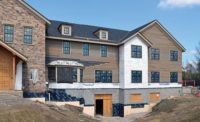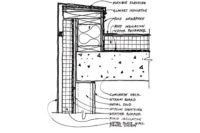
The renewed emphasis on energy conservation in building codes has led to increased awareness of the importance of controlling air leakage of buildings. One of the most effective ways to conserve energy is to provide an airtight building envelope. Various types of products-fluid applied, polymer based sheet wraps and asphaltic self-adhered membranes-are being used to provide air leakage resistance in wall assemblies. Sometimes, these products are used without consideration of their potential impact on fire performance of the wall assembly.
Building codes are established to provide physical safety to the building occupants and fire protection is a significant component of the codes. Building construction is classified into types based on the use and occupancy of the building. Institutional and many commercial buildings are required to be of “non-combustible” construction (typically steel frame, concrete or masonry). One and two family dwellings and some commercial structures can be “combustible” construction (typically wood frame).
Sometimes, combustible materials are used in the construction of buildings that are required to be noncombustible. This sounds like an oxymoron, but the codes allow for this provided certain testing is performed and the materials meet criteria established by the codes.
Test Methods
Three fire tests are used to evaluate exterior wall materials and assemblies for use in noncombustible construction:- ASTM E84, Standard Test Method for Surface Burning Characteristics of Building Materials
- NFPA 285, Method of Test for the Evaluation of Flammability Characteristics of Exterior Non-bearing Wall Assemblies Containing Combustible Components
- NFPA 268, Test Method for Determining Ignitibility of Exterior Wall Assemblies Using a Radiant Heat Energy Source
A fourth test, ASTM E 119, Test Methods for Fire Tests of Building Construction and Materials, is sometimes required in addition to the above tests when walls are required to have an hourly fire-resistance rating.
NFPA 285, NFPA 268 and ASTM E 119 are tests of the wall assembly. Alternate materials cannot necessarily be substituted for individual components of fire-tested assemblies without changing the fire performance. A qualified fire consultant should be involved if any substitutions are proposed.
(Note: comparable Canadian fire testing standards and alternate Underwriters Laboratory versions of some of these tests may be acceptable depending on the applicable code requirements.)
ASTM E 84
ASTM E 84 characterizes the relative rate at which flame will spread as the subject material burns. This test method is often referred to as the “Tunnel Test” because the test chamber is a nominal 25-foot-long by 20-inch wide chamber. A gas burner is lit at one end of the chamber and a draft is applied to facilitate flame propagation along the specimen. A photometer and light source is placed at the exhaust end of the chamber to measure the relative amount of smoke that is developed during the test. The test is run for 10 minutes and the distance that the flame propagates during that time is measured and compared against a standard. The Flame Spread Index is a relative indication of the flammability of the test material with respect to a red oak standard. Both the distance of flame spread and the time-rate of flame spread are considered as part of calculating a Flame Spread Index. Overly simplified, a reported Flame Spread Index of 25 indicates that a material has approximately 25 percent of the standard material’s flame spread characteristics. The “smoke developed index” is calculated similarly. Section 803.1.1 of the International Building Code defines three classes of materials based on ASTM E 84 test results (as shown in Chart 1).A combustible material is required to conform to the Class A requirements to be used in noncombustible exterior wall construction.

NFPA 285
NFPA 285 is commonly referred to as the “intermediate scale” or “ISMA” test. This test was developed to evaluate the fire performance of EIFS and other foam plastic-based wall systems. The test addresses the concern that fire could propagate through the combustible insulation and move from floor to floor, or laterally. The test involves constructing the test wall on one side of a two-story noncombustible (concrete block) chamber. The test wall has a window opening into the lower floor room. A burner in the bottom floor room is ignited and allowed to burn for five minutes.This part of the test is intended to simulate a real fire condition where the fire grows inside a room and then exits an opening, exposing the exterior wall cladding to fire. After five minutes a second gas burner, placed at the head of the window opening, is ignited and allowed to burn for 25 minutes. During the test numerous thermocouples embedded at different locations within the test wall are used to record temperature rise. Video is used to document conditions in the upper floor room (no window openings) to check for flame impingement or smoke entering the room. Visual observations of the height and lateral spread of flame that occurs on the exterior wall are also recorded. When the test is completed, if a visible failure does not occur, the thermocouple data is used to evaluate the amount of flame spread within the wall assembly. Lateral and vertical flame propagation limits as well as thermocouple temperature limits must be met in order to meet building code criteria.
NFPA 268
NFPA 268 is designed to assess the potential of a fire in one building to ignite an adjacent building, for example, across a narrow street or alley. This test is useful to establish minimum set-backs from property lines in urban areas for buildings with combustible cladding. The test is run by placing a gas-fired radiant heater a set distance from the exterior surface of the test wall assembly for 20 minutes. The heater and test configuration is calibrated to provide a heat flux of 12.5 kW/m². The radiant heat causes some materials to ignite, which is an indication of failure. An electric igniter (similar to that used to start a gas grill) is placed at the exterior surface of the test wall and is sparked repeatedly during the test to determine if ignitable gasses are being produced that might otherwise be undetected. After the heat exposure the wall is allowed to cool and the test panel is dissected to check the conditions of materials that are not visible.In the case of air barrier materials that are behind cladding, this test both confirms the resistance to the conditions tested and provides information regarding whether the air barrier materials remain intact and in place in this type of fire exposure. Materials that soften at relatively low temperatures could become dislodged or melt, compromising the integrity of the air barrier in a wall that is otherwise unaffected by the fire.
ASTM E 119
ASTM E 119 tests the hourly fire resistance rating for a wall assembly. An hourly fire rating is the time a wall assembly can be expected to contain a fire and, in the case of load-bearing walls, continue to provide some structural support. This test is not a requirement for a material to be used in noncombustible construction, but can be a requirement based on the construction and occupancy types for the building. Chapter 6 of the IBC identifies where hourly-rated wall assemblies are required and what the required hourly rating is for the respective building classifications. Chapter 7 of the IBC contains a list of typical rated wall assemblies.Combustible materials may be used in fire-rated assemblies, provided they do not change the fire rating. In other words, if a wall assembly is rated as a “two-hour” wall, adding a combustible element must not cause the fire endurance rating to be less than two hours. The air barrier material is more likely to have an effect as its mass and combustibility increase. Both mass and combustibility contribute to the overall fuel load available to burn. Hourly ratings for assemblies can be established both by testing and analysis.

Waterproof Air Barrier Membranes
In the case of our company, the fire safety of StoGuard waterproof air barrier membranes has been tested either individually or as the air barrier component in wall assemblies using the four test methods described above by accredited laboratories in the U.S. and Canada. Part of the selection process for any air barrier material or air barrier system in the wall assembly must include verification of fire safety as evidenced by independent testing and evaluation, and an ICC ES or CCMC evaluation report.References
2009 International Building Code, International Code Council, 2009NFPA 285, Standard Fire Test Method for Evaluation of Fire Propagation Characteristics of Exterior Non-Load-Bearing Wall Assemblies Containing Combustible Components, National Fire Protection Association, Quincy, Mass.
NFPA 268, Standard Test Method for Determining Ignitibility of Exterior Wall Assemblies Using a Radiant Heat Energy Source, National Fire Protection Association, Quincy, Mass.
ASTM E 84, Standard Test Method for Surface Burning Characteristics of Building Materials, American Society for Testing and Materials, West Conshohocken, Pa.
ASTM E 119, Standard Test Methods for Fire Tests of Building Construction and Materials, American Society for Testing and Materials, West Conshohocken, Pa.



Report Abusive Comment